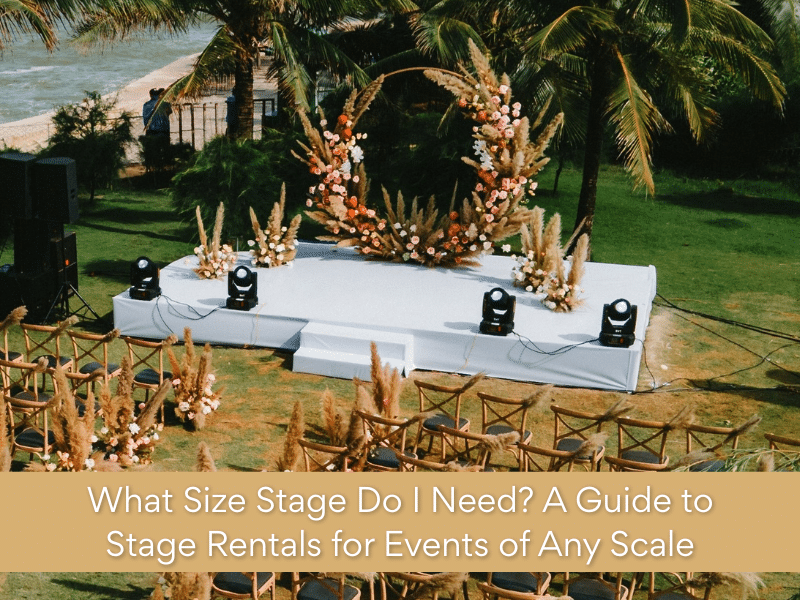When planning an event, choosing the right size for stage rentals is one of the most important decisions you’ll make, whether it’s a wedding, concert, school play, or a corporate presentation. A stage that’s too small can feel cramped and unprofessional, while a stage that’s too large may overwhelm the space and cost more than you anticipated.
If you’re renting a portable stage, understanding how to match stage dimensions to your event’s needs is key. It is important to consider the essential factors, size recommendations, and common mistakes to avoid so your event looks polished and runs smoothly.
Why Does Stage Size Matter?
The stage is the focal point of your event. It directs attention, elevates performers or speakers, and creates a sense of importance. The right stage size helps ensure everyone in the audience has a clear view, while also giving performers enough space to move comfortably and safely. Just as importantly, an appropriately sized stage creates a professional appearance that matches the scale of your venue and audience.
What are the Key Factors in Choosing the Proper Stage Size?
One of the first things to think about is the number of people who will be on the stage. A single presenter requires much less room than a wedding party or a full band. If you expect multiple people on stage at once, or performers who need to move around, you’ll need more square footage.
The type of event also plays a role. A corporate presentation usually requires a smaller stage than a dance recital or live concert, while ceremonies and graduations often involve large groups standing together at the same time.
Your venue and audience size also matter. A large ballroom or outdoor festival ground calls for a larger stage so it looks appropriate to the space and provides visibility from the back rows. In smaller venues like community halls, compact stages are typically the better choice.
Stage height is another consideration. Indoor events often use lower stages, around 12 to 24 inches high, while outdoor events with larger crowds may need higher platforms of 30 to 48 inches. Height directly affects visibility and should be chosen to match the setting.
Think about additional equipment that will take up space on the stage, including podiums, musical instruments, props, risers and lighting gear. You’ll also need room for stairs, ramps, or ADA-compliant access if required.
What are Some Common Mistakes to Avoid When Renting a Stage?
Event planners sometimes underestimate how much room is truly needed for an event. One of the biggest mistakes is forgetting about equipment, such as podiums, speakers, or drum kits, which can take up valuable stage space. Another common oversight is ignoring the size of the audience. A stage that feels sufficient for 50 guests may look far too small in front of 500 attendees.
It’s also easy to misjudge stage height, especially indoors. A tall stage in a small room can feel awkward and even reduce visibility for guests seated close by. Accessibility is another area where planners sometimes fall short. A ramp or extra stairs are not only useful but may be legally required to be ADA compliant. Finally, don’t underestimate movement needs. Choirs, dancers, and bands require more room than stationary speakers, and crowding can lead to discomfort or even accidents, so it’s important to rent the right sized stage for the event.
What Safety and Accessibility Considerations are Needed for Stage Rentals?
Stage size matters for both aesthetics and for keeping everyone safe. Always confirm that the stage you choose has the proper weight capacity to support the number of people and equipment you plan to place on it. Stability is essential, so look for portable stages with secure locking systems and non-slip surfaces.
Accessibility should also be a priority. Ideally, your stage should include at least two ways to enter and exit, such as stairs and a ramp. Ramps are especially important for ADA compliance and to accommodate guests or performers with mobility issues. Lastly, keep pathways clear of cables, props, and other obstructions to reduce tripping hazards and ensure smooth traffic flow on and off the stage. This ensures everyone can move around safely and enjoy the event without incident.
Whether you are planning a corporate event, an elaborate wedding or a local talent show, be sure to work with a reputable event planner that can help determine the perfect size and height of portable stage needed for your event.
- How To Plan a Business Holiday Party That Employees and Clients Will Never Forget - November 14, 2025
- What Size Stage Do I Need? A Guide to Stage Rentals for Events of Any Scale - October 15, 2025
- Dance Floor Rentals – Dancing in Style - June 18, 2024

